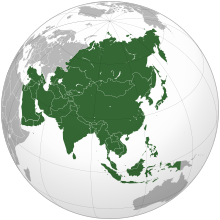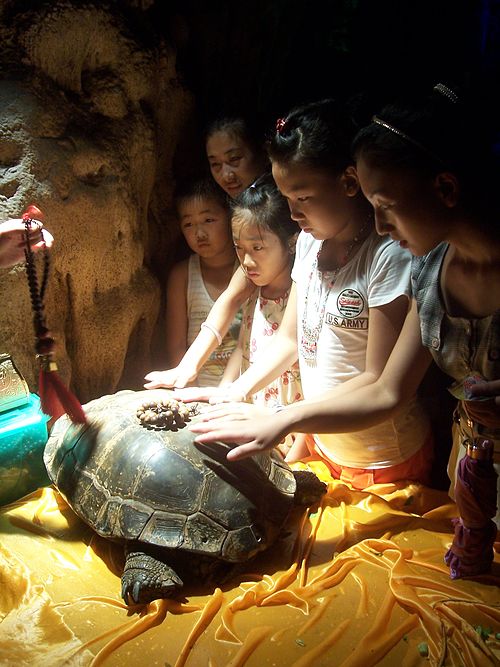Portal:Asia

 Asia (/ˈeɪʒə/ AY-zhə, UK also /ˈeɪʃə/ AY-shə) is the largest continent in the world by both land area and population. It covers an area of more than 44 million square kilometers, about 30% of Earth's total land area and 8% of Earth's total surface area. The continent, which has long been home to the majority of the human population, was the site of many of the first civilizations. Its 4.7 billion people constitute roughly 60% of the world's population. Asia shares the landmass of Eurasia with Europe, and of Afro-Eurasia with both Europe and Africa. In general terms, it is bounded on the east by the Pacific Ocean, on the south by the Indian Ocean, and on the north by the Arctic Ocean. The border of Asia with Europe is a historical and cultural construct, as there is no clear physical and geographical separation between them. It is somewhat arbitrary and has moved since its first conception in classical antiquity. The division of Eurasia into two continents reflects East–West cultural, linguistic, and ethnic differences, some of which vary on a spectrum rather than with a sharp dividing line. A commonly accepted division places Asia to the east of the Suez Canal separating it from Africa; and to the east of the Turkish Straits, the Ural Mountains and Ural River, and to the south of the Caucasus Mountains and the Caspian and Black seas, separating it from Europe. China and India traded places as the largest economies in the world from 1 to 1800 CE. China was a major economic power for much of recorded history, with the highest GDP per capita until 1500. The Silk Road became the main east–west trading route in the Asian hinterlands while the Straits of Malacca stood as a major sea route. Asia has exhibited economic dynamism as well as robust population growth during the 20th century, but overall population growth has since fallen. Asia was the birthplace of most of the world's mainstream religions including Hinduism, Zoroastrianism, Judaism, Jainism, Buddhism, Confucianism, Taoism, Christianity, Islam, Sikhism, as well as many other religions. (Full article...) Featured articleGyeongju (Korean: 경주, pronounced [kjʌ̹ŋ.dʑu]), historically known as Seorabeol (서라벌, pronounced [sʰʌ̹.ɾa̠.bʌɭ]), is a coastal city in the far southeastern corner of North Gyeongsang Province, South Korea. It is the second largest city by area in the province after Andong, covering 1,324 km2 (511 sq mi) with a population of 264,091 people . Gyeongju is 370 km (230 mi) southeast of Seoul, and 55 km (34 mi) east of Daegu. The city borders Cheongdo and Yeongcheon to the west, Ulsan to the south and Pohang to the north, while to the east lies the coast of the Sea of Japan. Numerous low mountains—outliers of the Taebaek range—are scattered around the city. Gyeongju was the capital of the ancient kingdom of Silla (57 BC – 935 AD), which ruled about two-thirds of the Korean peninsula at its height between the 7th and 9th centuries, for close to one thousand years. Later Silla was a prosperous and wealthy country, and Gyeongju was the fourth largest city in the world. A vast number of archaeological sites and cultural properties from this period remain in the city. Gyeongju is often referred to as "the museum without walls". Among such historical treasures, Seokguram grotto, Bulguksa temple, Gyeongju Historic Areas and Yangdong Folk Village are designated as World Heritage Sites by UNESCO. The many major historical sites have helped Gyeongju become one of the most popular tourist destinations in South Korea. (Full article...)Selected Country Laos, officially the Lao People's Democratic Republic (Lao PDR or LPDR), is the only landlocked country in Southeast Asia. At the heart of the Indochinese Peninsula, Laos is bordered by Myanmar and China to the northwest, Vietnam to the east, Cambodia to the southeast, and Thailand to the west and southwest. Its capital and largest city is Vientiane. Present-day Laos traces its historic and cultural identity to Lan Xang, which existed from the 13th century to the 18th century as one of the largest kingdoms in Southeast Asia. Because of its central geographical location in Southeast Asia, the kingdom became a hub for overland trade and became wealthy economically and culturally. After a period of internal conflict, Lan Xang broke into three separate kingdoms: Luang Phrabang, Vientiane and Champasak. In 1893, the three kingdoms came under a French protectorate and were united to form what is now known as Laos. (Full article...)Featured biographyZhou Tong (Chinese: 周同 and 周侗; pinyin: Zhōu Tóng) (died late 1121 CE) was the archery teacher and second military arts tutor of famous Song dynasty general Yue Fei. Originally a local hero from Henan, he was hired to continue Yue Fei's military training in archery after the boy had rapidly mastered spearplay under his first teacher. In addition to the future general, Zhou accepted other children as archery pupils. During his tutelage, Zhou taught the children all of his skills and even rewarded Yue with his two favorite bows because he was his best pupil. After Zhou's death, Yue would regularly visit his tomb twice a month and perform unorthodox sacrifices that far surpassed that done for even beloved tutors. Yue later taught what he had learned from Zhou to his soldiers and they were successful in battle. With the publishing of Yue Fei's 17th folklore biography, The Story of Yue Fei (1684), a new, fictional Zhou Tong emerged, who differed greatly from his historical persona. Not only was he now from Shaanxi, but he was Yue's adopted father, a learned scholar with knowledge of the eighteen weapons of war, and his personal name was spelled with a different, yet related, Chinese character. The novel's author portrayed him as an elderly widower and military arts tutor who counted Lin Chong and Lu Junyi, two of the fictional 108 outlaws on which the Water Margin is based, among his former pupils. A later republican era folktale by noted Yangzhou storyteller Wang Shaotang not only adds Wu Song to this list, but represents Zhou as a knight-errant with supreme swordsmanship. The tale also gives him the nickname "Iron Arm", which he shares with the executioner-turned-outlaw Cai Fu, and makes the outlaw Lu Zhishen his sworn brother. Because of his association with the outlaws, he is often confused with the similarly named outlaw Zhou Tong. (Full article...)General imagesThe following are images from various Asia-related articles on Wikipedia. Featured picture Credit: Paul Munhoven In the grotto of the flute reeds, China, a family shows reverence for an ancient turtle. The turtle is a symbol of longevity throughout many parts of Asia. Its four feet represent the four corners of the earth, its endurance is considered to last 10,000 years. A symbol of good luck and long life, many turtles are pushed towards extinction by consumption in Chinese medicine.
Did you know...
Updated: 6:33, 14 February 2024 In the news
Related portalsMajor Religions in Asia Middle East Central Asia and Surroundings Indian Subcontinent Southeast Asia East Asia Selected panorama
This image by the firm of Maison Bonfils depicts the city of Beirut, Lebanon, sometime in the last third of the 19th century. Maison Bonfils was the extraordinarily prolific venture of the French photographer Félix Bonfils (1831–85), his wife Marie-Lydie Cabanis Bonfils (1837–1918), and their son, Adrien Bonfils (1861–1928). The Bonfils moved to Beirut in 1867 and, over the next five decades, their firm produced one of the world's most important bodies of photographic work about the Middle East. Maison Bonfils was known for landscape photographs, panoramas, biblical scenes, and posed “ethnographic” portraits. TopicsCategoriesAssociated WikimediaThe following Wikimedia Foundation sister projects provide more on this subject:
More portalsShortcuts to this page: Asia portal • P:ASIA Purge server cache |






























































































